State-Of-The-Art in Microgrid-Integrated Distributed Energy Storage Sizing
Abstract
:1. Introduction
2. Microgrid-Integrated DES Sizing Methods
2.1. Cost-Based DES Sizing Methods
2.2. Non-Cost-Based DES Sizing Methods
- Some of the reviewed papers adopt a short planning horizon such as one day. In this case, the seasonal variations of the renewable generation, load demand, and electricity price are not considered in the DES sizing problem. As a result, the determined optimal size may not be accurate and the installed DES performance will be affected.
- The impact of the DES operating factors such as depth of discharge and number of cycles on its lifetime (i.e., DES degradation) are rarely included in the reviewed papers. This may result in the necessity to replace the DES before the end of the considered project lifetime which imposes an extra cost to the planning problem that has not been considered when the DES is sized.
- Most of the papers consider only one DES technology in the planning problem. Moreover, the optimal location at which the DES should be installed within the microgrid is normally ignored.
3. Proposed DES Sizing Method
3.1. Impact of DES Operation on Lifetime
3.2. Proposed DES Sizing Mathematical Formulation
- Microgrid operational and physical constraints such as line capacity limits and bus voltage limits. These constraints are selected by the microgrid planner and added to the formulation.
- Candidate DES technologies and characteristics such as power rating and energy rating capital costs, modular size (Δxe), roundtrip efficiency (ηe), discharging periods (τ), and maximum depth of discharge ().
- The manufacturer depth of discharge versus lifecycle curve for each candidate DES technology, which will be linearized and used to derive the DES degradation parameter (αem).
3.3. The Proposed DES Sizing Model vs. Existing Models
4. Conclusions
Author Contributions
Conflicts of Interest
References
- Department of Energy Office of Electricity Delivery and Energy Reliability. Summary Report: 2012 DOE Microgrid Workshop. 2012. Available online: http://energy.gov/sites/prod/files/2012%20Microgrid%20Workshop%20Report%2009102012.pdf (accessed on 1 November 2015).
- Parhizi, S.; Lotfi, H.; Khodaei, A.; Bahramirad, S. State of the Art in Research on Microgrids: A Review. IEEE Access 2015, 3, 890–925. [Google Scholar] [CrossRef]
- Eyer, J.; Corey, G. Energy Storage for the Electricity Grid: Benefits and Market Potential Assessment Guide; Sandia National Laboratories: Albuquerque, NM, USA, 2010; Volume 20, p. 5. [Google Scholar]
- Bahramirad, S.; Daneshi, H. Optimal sizing of smart grid storage management system in a microgrid. In Proceedings of the IEEE PES Innovative Smart Grid Technologies (ISGT), Washington, DC, USA, 16–20 January 2012; pp. 1–7. [Google Scholar]
- Bahramirad, S.; Reder, W.; Khodaei, A. Reliability-Constrained Optimal Sizing of Energy Storage System in a Microgrid. IEEE Trans. Smart Grid 2012, 3, 2056–2062. [Google Scholar] [CrossRef]
- Hajipour, E.; Bozorg, M.; Fotuhi-Firuzabad, M. Stochastic Capacity Expansion Planning of Remote Microgrids With Wind Farms and Energy Storage. IEEE Trans. Sustain. Energy 2015, 6, 491–498. [Google Scholar] [CrossRef]
- Alsaidan, I.; Khodaei, A.; Gao, W. Distributed energy storage sizing for microgrid applications. In Proceedings of the IEEE/PES Transmission and Distribution Conference and Exposition (T&D), Dallas, TX, USA, 3–5 May 2016; pp. 1–5. [Google Scholar]
- Alsaidan, I.; Khodaei, A.; Gao, W. Determination of battery energy storage technology and size for standalone microgrids. In Proceedings of the IEEE Power and Energy Society General Meeting (PESGM), Boston, MA, USA, 17–21 July 2016; pp. 1–5. [Google Scholar]
- Alsaidan, I.; Khodaei, A.; Gao, W. Determination of optimal size and depth of discharge for battery energy storage in standalone microgrids. In Proceedings of the North American Power Symposium (NAPS), Denver, CO, USA, 18–20 September 2016; pp. 1–6. [Google Scholar]
- Alharbi, H.; Bhattacharya, K. Optimal Sizing of Battery Energy Storage Systems for Microgrids. In Proceedings of the IEEE Electrical Power and Energy Conference (EPEC), Calgary, AB, Canada, 12–14 November 2014; pp. 275–280. [Google Scholar]
- Fossati, J.P.; Galarza, A.; Martín-Villate, A.; Fontán, L. A method for optimal sizing energy storage systems for microgrids. Renew. Energy 2015, 77, 539–549. [Google Scholar] [CrossRef]
- Carpinelli, G.; Celli, G.; Mocci, S.; Mottola, F.; Pilo, F.; Proto, D. Optimal Integration of Distributed Energy Storage Devices in Smart Grids. IEEE Trans. Smart Grid 2013, 4, 985–995. [Google Scholar] [CrossRef]
- Zhou, N.; Liu, N.; Zhang, J.; Lei, J. Multi-Objective Optimal Sizing for Battery Storage of PV-Based Microgrid with Demand Response. Energies 2016, 9, 591. [Google Scholar] [CrossRef]
- Jiao, B.; Wang, C.; Guo, L. Scenario Generation for Energy Storage System Design in Stand-alone Microgrids. Energy Procedia. 2014, 61, 824–828. [Google Scholar] [CrossRef]
- Khorramdel, H.; Aghaei, J.; Khorramdel, B.; Siano, P. Optimal Battery Sizing in Microgrids Using Probabilistic Unit Commitment. IEEE Trans. Ind. Inform. 2016, 12, 834–843. [Google Scholar] [CrossRef]
- Xiao, H.; Pei, W.; Yang, Y.; Kong, L. Sizing of battery energy storage for micro-grid considering optimal operation management. In Proceedings of the International Conference on Power System Technology (POWERCON), Chengdu, China, 20–22 October 2014; pp. 3162–3169. [Google Scholar]
- Kerdphol, T.; Qudaih, Y.; Mitani, Y. Optimum battery energy storage system using PSO considering dynamic demand response for microgrids. Int. J. Electr. Power Energy Syst. 2016, 83, 58–66. [Google Scholar] [CrossRef]
- Kerdphol, T.; Qudaih, Y.; Mitani, Y. Battery energy storage system size optimization in microgrid using particle swarm optimization. In Proceedings of the IEEE PES Innovative Smart Grid Technologies Conference Europe (ISGT-Europe), Istanbul, Turkey, 12–15 October 2014; pp. 1–6. [Google Scholar]
- Xie, X.; Wang, H.; Tian, S.; Liu, Y. Optimal capacity configuration of hybrid energy storage for an isolated microgrid based on QPSO algorithm. In Proceedings of the 5th International Conference on Electric Utility Deregulation and Restructuring and Power Technologies (DRPT), Changsha, China, 26–29 November 2015; pp. 2094–2099. [Google Scholar]
- Bahmani-Firouzi, B.; Azizipanah-Abarghooee, R. Optimal sizing of battery energy storage for micro-grid operation management using a new improved bat algorithm. Int. J. Electr. Power Energy Syst. 2014, 56, 42–54. [Google Scholar] [CrossRef]
- Sharma, S.; Bhattacharjee, S.; Bhattacharya, A. Grey wolf optimisation for optimal sizing of battery energy storage device to minimise operation cost of microgrid. IET Gener. Transm. Distrib. 2016, 10, 625–637. [Google Scholar] [CrossRef]
- Mohammadi, S.; Mohammadi, A. Stochastic scenario-based model and investigating size of battery energy storage and thermal energy storage for micro-grid. Int. J. Electr. Power Energy Syst. 2014, 61, 531–546. [Google Scholar] [CrossRef]
- Nguyen, T.A.; Crow, M.L.; Elmore, A.C. Optimal Sizing of a Vanadium Redox Battery System for Microgrid Systems. IEEE Trans. Sustain. Energy 2015, 6, 729–737. [Google Scholar] [CrossRef]
- Ross, M.; Hidalgo, R.; Abbey, C.; Joós, G. Analysis of Energy Storage sizing and technologies. In Proceedings of the IEEE Electric Power and Energy Conference (EPEC), Halifax, NS, Canada, 25–27 August 2010; pp. 1–6. [Google Scholar]
- Chen, S.X.; Gooi, H.B. Sizing of energy storage system for microgrids. In Proceedings of the IEEE 11th International Conference on Probabilistic Methods Applied to Power Systems (PMAPS), Singapore, 14–17 June 2010; pp. 6–11. [Google Scholar]
- Chen, S.X.; Gooi, H.B.; Wang, M.Q. Sizing of Energy Storage for Microgrids. IEEE Trans. Smart Grid 2012, 3, 142–151. [Google Scholar] [CrossRef]
- Dong, J.; Gao, F.; Guan, X.; Zhai, Q.; Wu, J. Storage-Reserve Sizing With Qualified Reliability for Connected High Renewable Penetration Micro-Grid. IEEE Trans. Sustain. Energy 2016, 7, 732–743. [Google Scholar] [CrossRef]
- Khasawneh, H.J.; Mondal, A.; Illindala, M.S.; Schenkman, B.L.; Borneo, D.R. Evaluation and sizing of energy storage systems for microgrids. In Proceedings of the IEEE/IAS 51st Industrial Commercial Power Systems Technical Conference (I&CPS), Calgary, AB, Canada, 5–8 May 2015; pp. 1–8. [Google Scholar]
- Koohi-Kamali, S.; Rahim, N.A.; Mokhlis, H. New algorithms to size and protect battery energy storage plant in smart microgrid considering intermittency in load and generation. In Proceedings of the 3rd IET International Conference on Clean Energy and Technology (CEAT), Kuching, Malaysia, 24–26 November 2014; pp. 1–7. [Google Scholar]
- Keskamol, K.; Hoonchareon, N. Sizing of battery energy storage system for sustainable energy in a remote area. In Proceedings of the 2015 IEEE Innovative Smart Grid Technologies—Asia (ISGT ASIA), Bangkok, Thailand, 3–6 November 2015; pp. 1–4. [Google Scholar]
- Beiranvand, A.; Aghdam, M.M.; Li, L.; Zhu, S.; Zheng, J. Finding the optimal place and size of an energy storage system for the daily operation of microgrids considering both operation modes simultaneously. In Proceedings of the 2016 IEEE International Conference on Power System Technology (POWERCON), Wollongong, NSW, Australia, 28 September–1 October 2016; pp. 1–6. [Google Scholar]
- Sun, C.; Yuan, Y. Sizing of hybrid energy storage system in independent microgrid based on BP neural network. In Proceedings of the 2nd IET Renewable Power Generation Conference (RPG 2013), Beijing, China, 9–11 September 2013; pp. 1–4. [Google Scholar]
- Kerdphol, T.; Tripathi, R.N.; Hanamoto, T.; Khairudin; Qudaih, Y.; Mitani, Y. ANN based optimized battery energy storage system size and loss analysis for distributed energy storage location in PV-microgrid. In Proceedings of the 2015 IEEE Innovative Smart Grid Technologies—Asia (ISGT ASIA), Bangkok, Thailand, 3–6 November 2015; pp. 1–6. [Google Scholar]
- Hongesombut, K.; Piroon, T.; Weerakamaeng, Y. Evaluation of battery energy storage system for frequency control in microgrid system. In Proceedings of the 2013 10th International Conference on Electrical Engineering/Electronics, Computer, Telecommunications and Information Technology (ECTI-CON), Krabi, Thailand, 15–17 May 2013; pp. 1–4. [Google Scholar]
- Aghamohammadi, M.R.; Abdolahinia, H. A new approach for optimal sizing of battery energy storage system for primary frequency control of islanded Microgrid. Int. J. Electr. Power Energy Syst. 2014, 54, 325–333. [Google Scholar] [CrossRef]
- Toliyat, A.; Kwasinski, A. Energy storage sizing for effective primary and secondary control of low-inertia microgrids. In Proceedings of the 2015 IEEE 6th International Symposium on Power Electronics for Distributed Generation Systems (PEDG), Aachen, Germany, 22–25 June 2015; pp. 1–7. [Google Scholar]
- Jia, H.; Mu, Y.; Qi, Y. A statistical model to determine the capacity of battery–supercapacitor hybrid energy storage system in autonomous microgrid. Int. J. Electr. Power Energy Syst. 2014, 54, 516–524. [Google Scholar] [CrossRef]
- Khodaei, A. Resiliency-Oriented Microgrid Optimal Scheduling. IEEE Trans. Smart Grid 2014, 5, 1584–1591. [Google Scholar] [CrossRef]
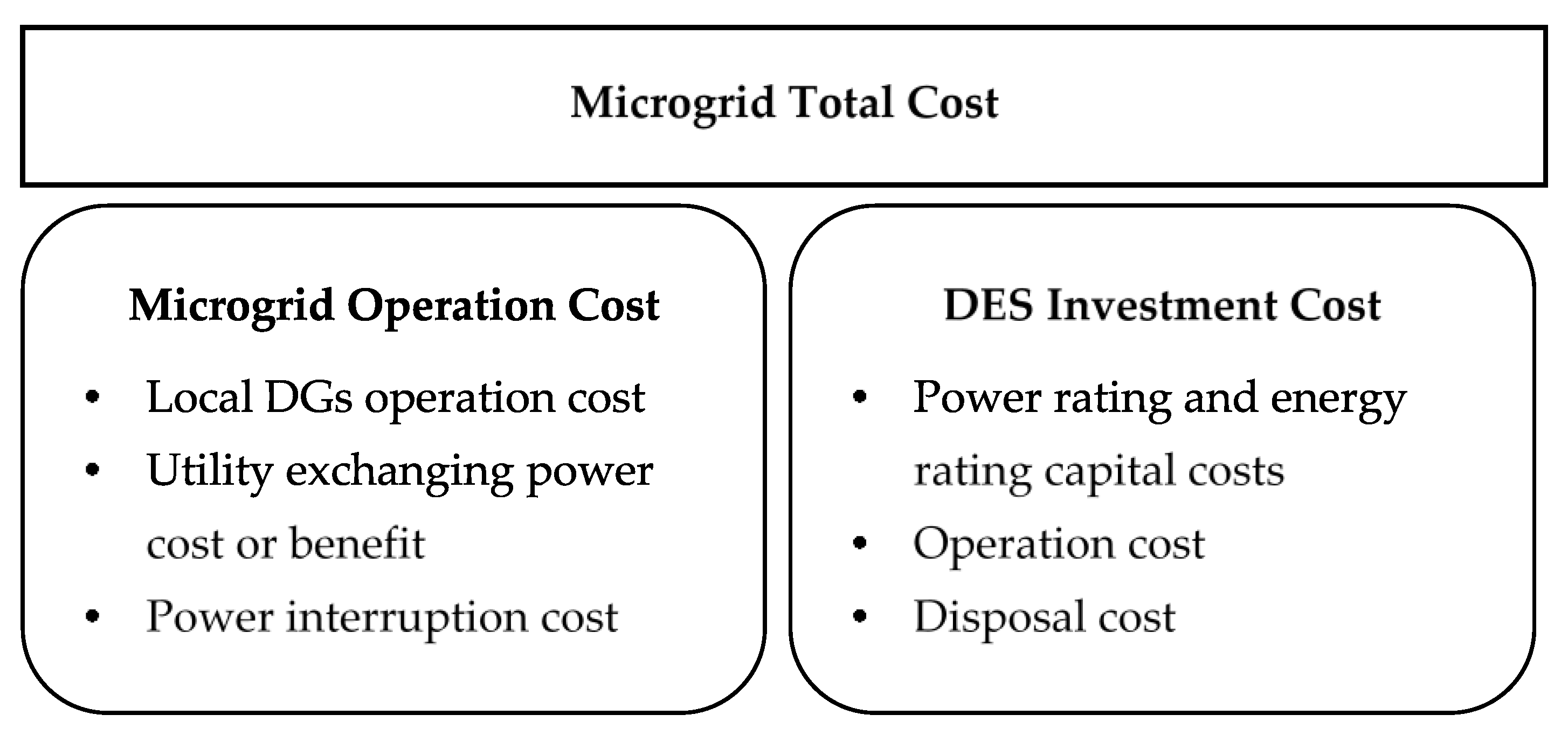
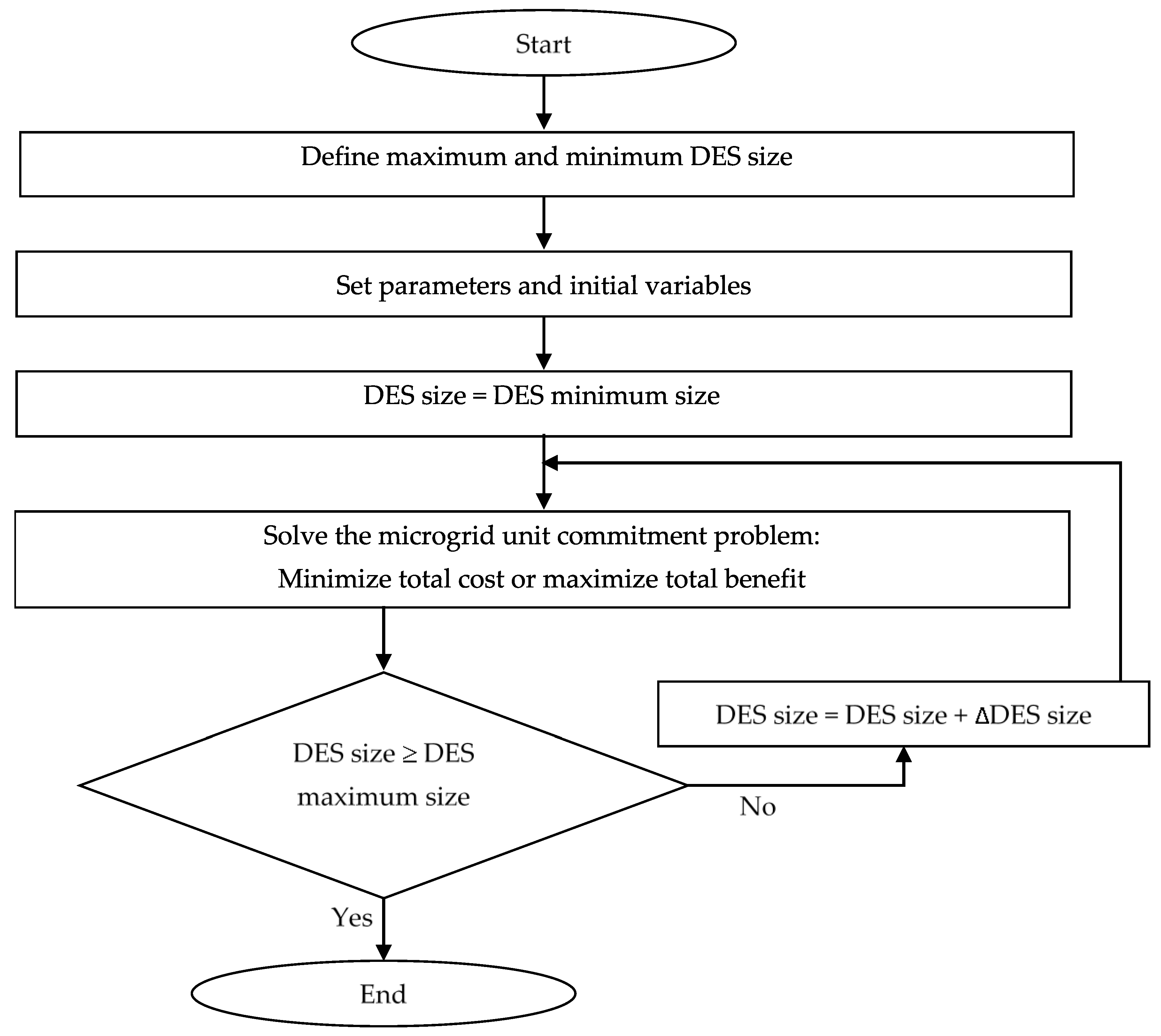
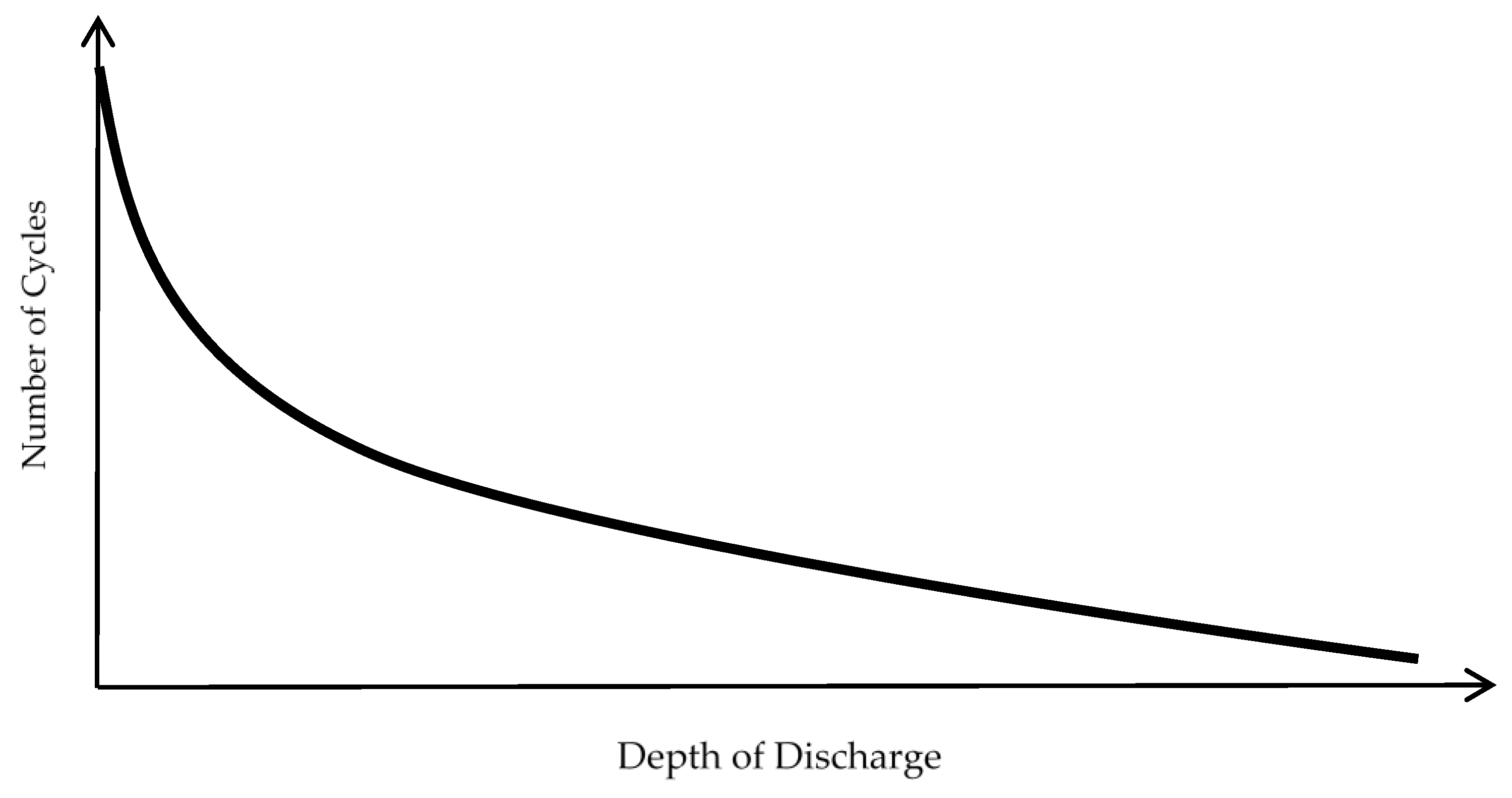
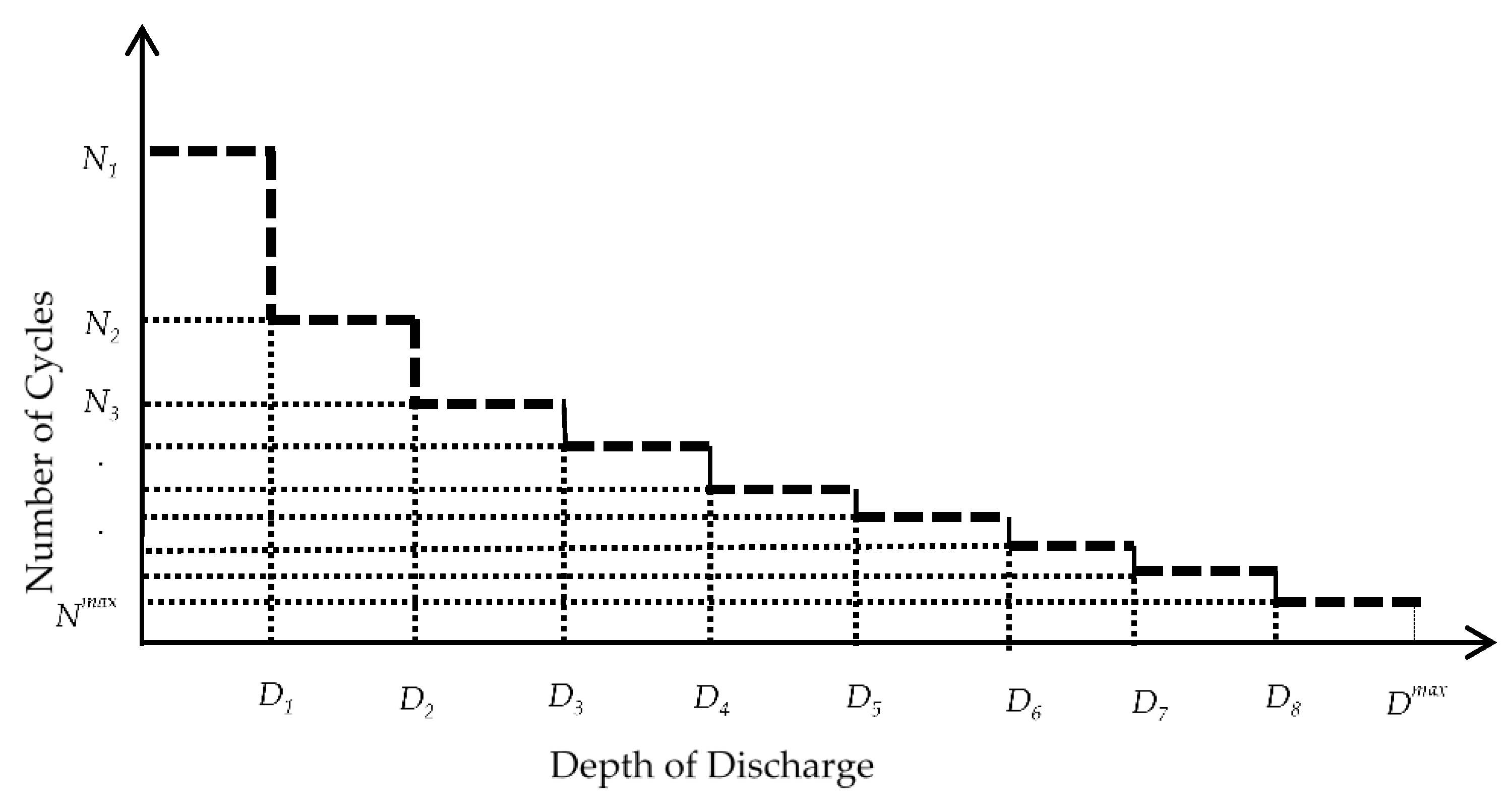
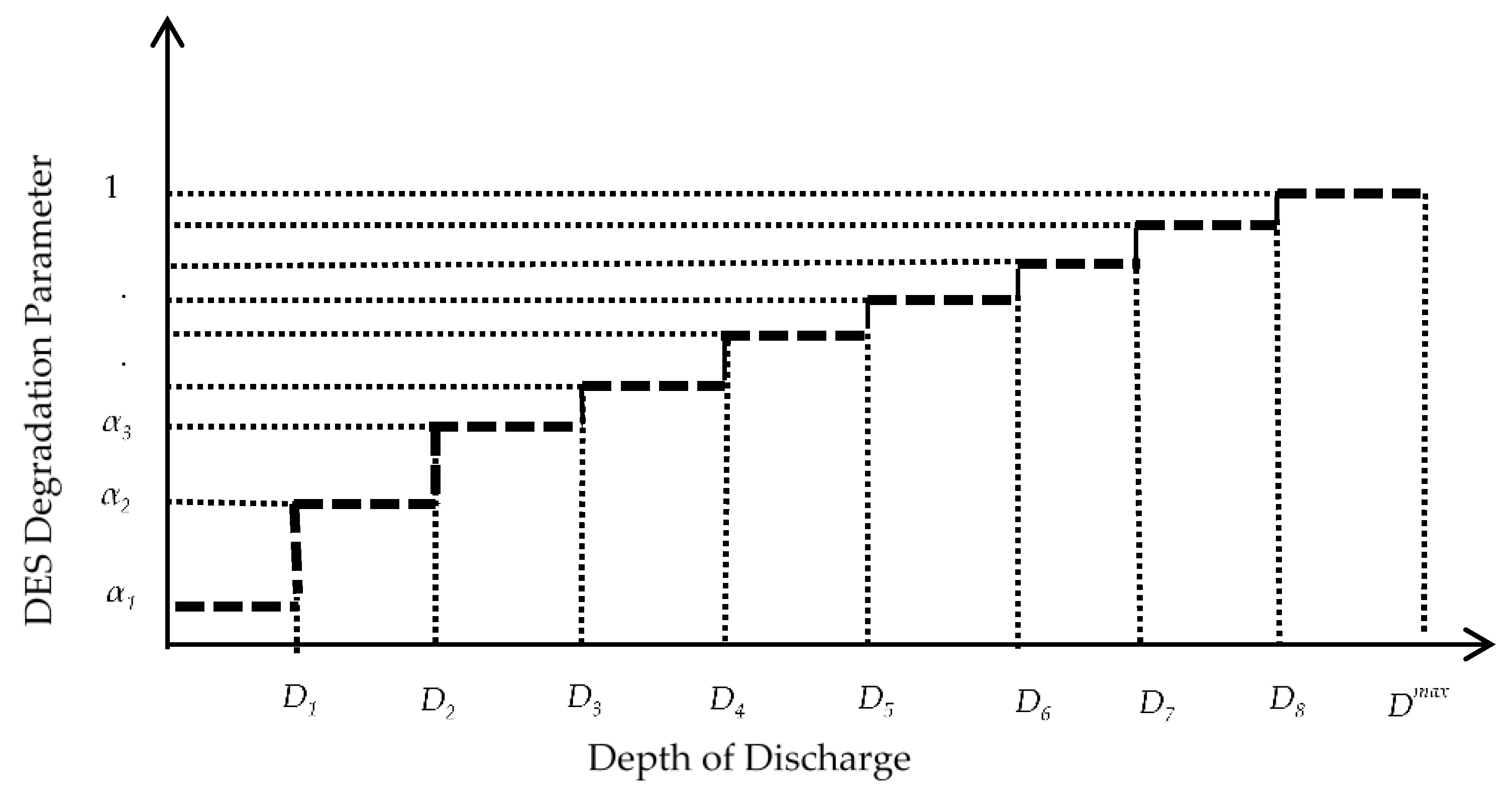
| Reference Number | Microgrid Operation Mode | DES Optimized Characteristics | Impact of DES Operation on Lifetime | Planning Timeframe | |||||
|---|---|---|---|---|---|---|---|---|---|
| Grid-Connected | Isolated or Islanded | Power Rating | Energy Rating | Technology | Location | Short | Long | ||
| [4] | √ | × | √ | × | × | × | × | × | √ |
| [5] | √ | × | √ | √ | × | × | × | × | √ |
| [6] | × | √ | √ | × | × | × | √ | × | √ |
| [7] | √ | × | √ | √ | × | × | × | × | √ |
| [8] | × | √ | √ | √ | √ | × | × | × | √ |
| [9] | × | √ | √ | √ | × | × | √ | × | √ |
| [10] | × | √ | √ | √ | × | × | × | × | √ |
| [11] | √ | × | √ | √ | × | × | √ | √ | × |
| [12] | √ | × | √ | × | × | √ | × | × | √ |
| [13] | √ | × | × | √ | × | × | × | × | √ |
| [14] | × | √ | × | √ | × | × | × | √ | × |
| [15] | √ | √ | × | √ | × | × | × | √ | × |
| [16] | √ | √ | √ | √ | × | × | × | × | √ |
| [17] | × | √ | √ | × | × | × | × | √ | × |
| [18] | × | √ | √ | × | × | × | × | √ | × |
| [19] | × | √ | × | √ | × | × | × | √ | × |
| [20] | √ | × | × | √ | × | × | × | √ | × |
| [21] | √ | × | × | √ | × | × | × | √ | × |
| [22] | √ | × | × | √ | × | × | × | √ | × |
| [23] | √ | √ | √ | √ | × | × | × | √ | × |
| [24] | × | √ | √ | √ | √ | × | × | × | √ |
| [25] | × | √ | × | √ | × | × | × | √ | × |
| [26] | √ | √ | × | √ | × | × | × | √ | × |
| [27] | √ | √ | × | √ | × | × | × | × | √ |
| [28] | × | √ | × | √ | × | × | × | √ | × |
| [29] | √ | × | √ | √ | × | × | × | √ | × |
| [30] | √ | × | √ | × | × | × | × | √ | × |
| [31] | √ | √ | √ | × | × | √ | × | √ | × |
| [32] | × | √ | × | √ | × | × | × | √ | × |
| [33] | × | √ | √ | × | × | × | × | √ | × |
| [34] | × | √ | √ | √ | × | × | × | √ | × |
| [35] | × | √ | √ | × | × | × | × | √ | × |
| [36] | × | √ | √ | √ | × | × | × | √ | × |
| [37] | × | √ | √ | √ | × | × | × | √ | × |
| This paper | √ | √ | √ | √ | √ | √ | √ | × | √ |
© 2017 by the authors. Licensee MDPI, Basel, Switzerland. This article is an open access article distributed under the terms and conditions of the Creative Commons Attribution (CC BY) license (http://creativecommons.org/licenses/by/4.0/).
Share and Cite
Alsaidan, I.; Alanazi, A.; Gao, W.; Wu, H.; Khodaei, A. State-Of-The-Art in Microgrid-Integrated Distributed Energy Storage Sizing. Energies 2017, 10, 1421. https://doi.org/10.3390/en10091421
Alsaidan I, Alanazi A, Gao W, Wu H, Khodaei A. State-Of-The-Art in Microgrid-Integrated Distributed Energy Storage Sizing. Energies. 2017; 10(9):1421. https://doi.org/10.3390/en10091421
Chicago/Turabian StyleAlsaidan, Ibrahim, Abdulaziz Alanazi, Wenzhong Gao, Hongyu Wu, and Amin Khodaei. 2017. "State-Of-The-Art in Microgrid-Integrated Distributed Energy Storage Sizing" Energies 10, no. 9: 1421. https://doi.org/10.3390/en10091421
APA StyleAlsaidan, I., Alanazi, A., Gao, W., Wu, H., & Khodaei, A. (2017). State-Of-The-Art in Microgrid-Integrated Distributed Energy Storage Sizing. Energies, 10(9), 1421. https://doi.org/10.3390/en10091421






